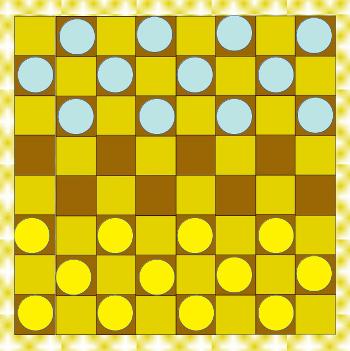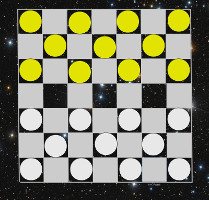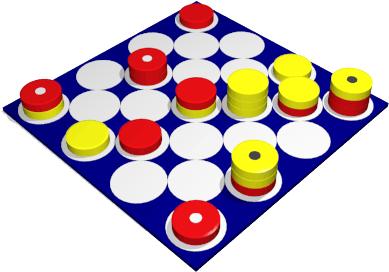Bashni and Lasca (or "Column Checkers")
Written by Howard Fosdick © BestFreeNewGames.com
Overview: Perhaps the most fun of all Checkers variants, Bashni is a Russian game that dates from the 19th century. It's always been popular there and it's a wonder so few people know it outside that country.
Bashni is sometimes called "column checkers" or "column draughts" because captured pieces are stacked atop one another.
Bashni has only a few rules that differ from those of standard American checkers, so you can learn it in a jif. But watch out! Game play is entirely different.
We'll also describe Lasca, a very similar game that gained some popularity in the 1920s. You'll find it in many games books as a fun Checkers alternative.
Bashni Differences from Checkers:
Here are the only rules that differ between Bashni and standard American checkers.
1. Common pieces ("men") can only move forwards, as in standard checkers. But unlike standard checkers, they can jump in any direction. Thus multiple jumps in any direction are possible for any piece in a single turn.
2. A jumped piece is not removed from the board. Instead it is placed beneath the piece that jumped it. This forms a column or stack . A column is controlled by the player whose piece sits topmost.
3. If the jumped piece is a column, only the uppermost piece is removed and reused from the opponent's captured column. The other pieces are left in place on the board. This animation shows how capture works in Bashni:

Courtesy of Wikipedia
4. There are "Men's columns" and "King's columns". The uppermost piece -- or "Commander" -- determines which type a column is at any time. The uppermost piece also shows which player currently controls the column.
5. If a piece touches the Kings row and becomes King during a jumping play, it continues jumping beyond the King's row if possible.
6. Kings can move any number of vacant diagonal squares in one turn (just like the Bishop in chess). Kings can therefore capture pieces to which they are not immediately adjacent, as long as there is a vacant square on the other side of the enemy piece upon which they can land.
Bashni Rules in Full:
Objective: You win the game either by capturing all enemy pieces, or by placing your opponent into a position where he can not move any piece. Should both players end up where neither can move a piece, the game ends in a draw. Draws also occur by mutual agreement.
Set Up: Set up the board and playing pieces as shown in the diagram. Randomly decide who will take the first turn (alternate in subsequent games).

Play: Pieces always move and reside on the dark squares only. In his turn, each player can move one piece.
Pieces move diagonally in forward direction (towards the opponent). They can not move vertically or horizontally, they only move diagonally. They can not move backwards, only forwards in the direction of your opponent -- with the exception that they can jump enemy pieces in any direction.
Jumping:
If your piece is next to an enemy piece and there is an open space on the other side, your checker jumps the enemy piece and lands in the open square opposite. The enemy piece is placed below your own, to form a column.
If your piece jumped an enemy column, place only its topmost piece below your own in forming your new column. Leave the remaining pieces of the jumped column in place.
Jumping is mandatory. If more than one jump is possible for a piece, the player may decide which jump to take. You do not have to take the jump sequence that results in the greatest number of captures. However, your piece must jump until no more jumps are possible.
You can perform multiple jumps with one piece in a single turn. Jumping can proceed in all directions, even for common (non-King) pieces. Thus common pieces never move backwards -- except in the case of jumping.
Kings:
If you move one of your pieces all the way across the board, to the final row, it becomes a King. Kings can move in both directions, forward and backward. They may move as many squares as are vacant in one direction (just like the Bishop in chess).
Kings may capture an enemy piece at a distance. The enemy piece must be accessible by a diagonal move (with no intervening pieces), and there must be an vacant square on the opposite side of the enemy piece for the King to land on.
A piece may be Kinged and continue its jumping sequence in a single turn.
Variants: I have seen rules on the internet that state that the King can move only one square in any direction in a turn. Perhaps this is a valid variant, but my friend who emigrated from Russia insists "This is not so! This is not so!" Certainly the rules for Russian Checkers, upon which Bashni is based, permit Bishop-like movement of all Kings.
Tips for Play: Winning strategies for Bashni are similar to those that work in most checkers variants. You can read about them here.
The big difference in Bashni is that when you jump a column, you only remove the topmost piece from that column. Who owns that jumped column now? The person who owns the new topmost piece on that column. And the behaviour of that jumped column is determined by its top piece (which could be either a Man or a King.) This definitely complicates jumping strategies!
The other big difference is that Kings can move any number of open diagonal spaces in one turn (like the Bishop in chess). They can therefore capture at a distance. The person who Kings a man first gains an immediate huge advantage, due to the King's greater mobility. The more open the board is, the greater the mobility of any King.
As you gain experience, you'll find that key to winning is setting up your opponent through forced captures. A sequence of captures matters little since captured men are not removed from the board. What matters is who controls the column after capture(s). If you can contrive to control your opponent's moves through forced captures but end up on top, that's all that counts.
Lasca
Lasca was introduced commercially in 1911 and enjoyed brief popularity through the 1920s. World Chess Champion Emanuel Lasker (1868–1941) created the game based on Bashni and American Checkers. Today it's included in most games compendia as a fun Checkers alternative.
Lasca takes the rules of American Checkers and adds Bashni's concept of column capture to them.
Lasca rules are the exact same as Bashni above except for these small but important differences:
- Play is on a 7 by 7 board
- Kings (or "Officers") can only move one square at a time -- not as many squares as are vacant across a diagonal
- Men capture only by jumping forward -- not in any direction as in Bashni. (Officers capture by jumping in any direction.)
- When a man becomes crowned an Officer, that move ends
The figure shows the starting positions of the men or "soldiers" in Lasca. Note that the elimination of the 8th rank and 8th row from the standard Checkers board means that all four corner positions are playable (black). This helps eliminate draws from the game.

You'll sometimes see Lasca boards with playable positions marked as circles in which to place the soldiers. These boards eliminate the non-playable positions from the visual. While these boards may look a bit different, the game is entirely unaffected by this change.
Print Your Own Game Boards: Want to print your own game board? We offer several different free images. Just click here. You don't need to buy anything to play!
Sources: Bashni and Lasca rules are widely available on the internet. The MindSports website is more comprehensive than many for Bashni and Lasca. Also check out Lasca.ora.
Click here for more free games on this website.
License: Feel free to print, copy, and distribute these rules, so long as you retain this paragraph. Written by Howard Fosdick © 2023, distributed under Creative Commons License BY-ND. HOME



